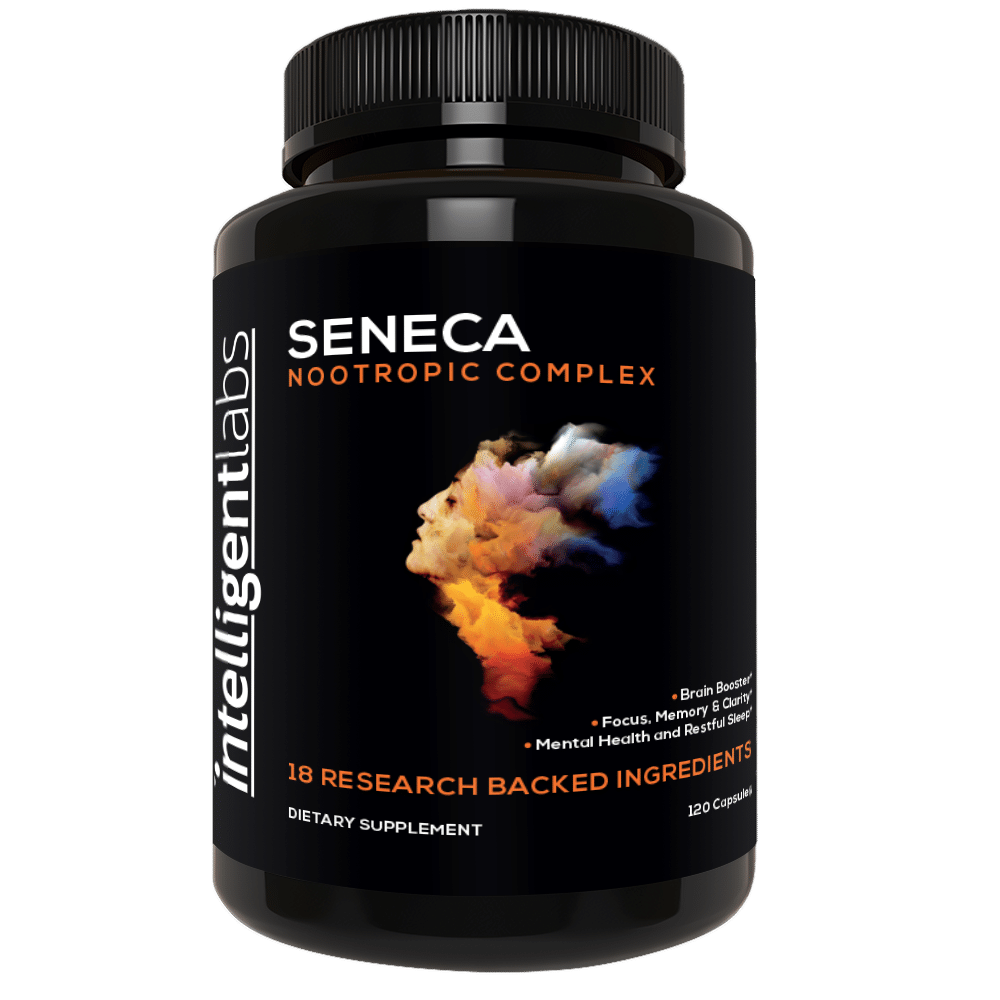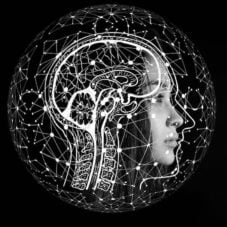Ashwagandha is so much more than just an exotic name. It’s actually a powerful nootropic and adaptogen in its own right, which is why it’s one of the ingredients in our Seneca Nootropic Complex. In this article, you’ll find out how it regulates cortisol levels, its effect on cognitive and thyroid function, and more!
Table of Contents
What is Ashwagandha?
Ashwagandha has been used for 6000 years in Ayurveda which is the traditional system of medicine in India. And if people have been using something for 6000 years, then that’s generally a pretty good sign.
It’s sometimes referred to as Indian Ginseng. But in Sanskrit, the term actually means “smell of the horse.” This is a reference to both its smell being like a horse and its ability to give you the power of a stallion as well!
People use it as an aphrodisiac. But they also take it to help with constipation, anxiety, insomnia, goiter, inflammation, and anti-aging (1). So far, more than 30 active ingredients have been isolated from this herb, including a group of chemicals known as ‘withanolides’ (2).
Ashwagandha benefits: What is it good for?
Here are 8 benefits of taking this adaptogenic herb:
Benefit #1 – Stress resistance
Studies in both animals and humans have shown the stress resilience abilities of ashwagandha.
For instance, in a forced cold water swimming test, rats treated with ashwagandha swam almost double the time versus the non-ashwagandha rats! Also, vitamin C levels were higher in the adrenals of the ashwagandha rats, indicating less oxidative stress. In other words, taking ashwagandha may mean stress is much less stressful (3).
A study conducted on 64 subjects in India reported the same results. The subjects were all free of physical or psychological diseases but felt chronically stressed. They all took 300mg of ashwagandha root twice a day for 60 days. At the end of the study, their cortisol levels went down significantly. They also felt better and had a higher quality of life after taking the root (4).
Benefit #2 – Regulation of sex hormones
A number of studies have reported ashwagandha’s effect on sex hormones. Here are the most notable ones we came across:
Overweight males aged 40-70 took 300mg of ashwagandha extract for 16 weeks. Their testosterone levels went up by 14.1% (5).
75 infertile men took 5g of this herb for 3 months. This resulted in higher testosterone levels, LH, FSH, and improved sperm counts and sperm quality (6).
Women who took 300mg 2x a day for 2 months had a significant increase in arousal, orgasm, lubrication, and sexual frequency (7).
Also, 51 menopausal women found that this herb helped normalize their estrogen levels. They also reported fewer hot flashes, balanced mood, improved sleep, and reduced irritability and anxiety (8).
Benefit #3 – Improvement in thyroid function
Cortisol and Metformin were given to type 2 diabetic mice which caused hypothyroidism. However, treatment with ashwagandha was able to restore thyroid hormone to normal levels (9).
A further study in 50 people with subclinical hypothyroidism found that after 8 weeks of treatment with 600mg of ashwagandha daily, T4, T3, and TSH levels had all normalized (10).
Benefit #4 – Neuroregeneration and Alzheimers
Researchers are able to create neurodegeneration, i.e. kill off brain cells and synapses in the brains of rats by injecting amyloid-beta proteins. These proteins form the amyloid plaques that are very common in the brains of Alzheimer’s patients. But this herb was able to stimulate axonal growth (11), as well as the regrowth of axons, dendrites, and synapses (12).
In fact, this herb can target the precursors to amyloid proteins. This stops the proteins from forming, potentially preventing the development of Alzheimer’s (13).
It’s worth noting that these studies don’t use human subjects. The researchers need to dissect the brains after the experiments to analyze the neurons.
Benefit #5 – Regenerating neuronal injuries
Ashwagandha can also help nerve cells to regenerate themselves after an injury, whether it be physical or chemical.
So, people can remain paralyzed after accidents because specialist cells known as ‘astrocytes’ secrete chemicals that stop the cut nerve axons from regenerating. Normally, astrocytes provide protection for neurons and supply them with nutrients. But when the spinal cord gets cut, they become ‘overprotective’ and stop the regeneration process.
However, a study reported that taking withanoside (one of the active components in ashwagandha) intravenously for several weeks induced axonal growth. It also allowed for the recovery of motor function in mice (14).
Benefit #6 – Antioxidant defense
Ashwagandha also helps up-regulate the transcription factor NRf2. This leads to the production of the body’s main antioxidant, Glutathione (13). Moreover, it also helps stimulate the production of other antioxidants, such as Super Oxide Dismutase and Catalase (15).
Benefit #7 – Acetylcholine, BDNF, and memory improvement
Scopolamine is a drug that can induce loss of muscle movement and memory loss. It inhibits acetylcholine receptors which are vital for movement, memory, and learning. It also inhibits the Brain Derived Neurotrophic Factor (BDNF), which is vital for cognitive function.

Ashwagandha can help prevent the effects of scopolamine by inhibiting its effects. It also helps increase levels of BDNF (16).
These benefits make ashwagandha an effective nootropic or memory enhancer! Each serving of our Seneca Nootropic includes 500mg of ashwagandha root powder, along with 17 other research-backed ingredients like Lion’s Mane, Bacopa Monnieri, and Ginkgo Biloba!
Related article: What are nootropics?
Benefit #8 – Antidepressant and anti-anxiety effects
A study in mice showed that it may also have an effect on anxiety, similar to lorazepam which acts on GABA receptors in the brain. It may also have the same anti-depressant effect as imipramine (17). Additionally, it could also activate the GABA receptors in rat brains (18).
What’s the proper ashwagandha dosage?
Most studies have looked at doses around the 250mg to 500mg range, although some have gone much higher. Some people also choose to take larger doses as it seems to have few side effects. However, higher doses should always be built up gradually.
How does ashwagandha work as an adaptogen?
Ashwagandha is best known as an adaptogen. An adaptogen is something that helps our body to normalize cortisol levels.
Cortisol is a strong anti-inflammatory and our ‘dealing with stress’ hormone. The more stress we are under, the more cortisol we produce to deal with that stress. So cortisol follows stress, be that physical inflammation, infection or injury, or psychological trauma.
Whether our cortisol levels are adequate or not is a little more complicated than just measuring whether they are high or low. For example, they could be high, but not actually high enough to deal with the stress we are under. This can happen when we face chronic inflammation or chronic psychological tension.
And this is the beauty of adaptogens. They can increase cortisol when it needs to be increased, and decrease when it needs to be decreased.
Conclusion
Ashwagandha is an effective adaptogen that can help to normalize cortisol levels as well as sex hormones and thyroid hormones. It can also protect the brain and promote healthy brain function. Hopefully, in the future, we will see more studies in humans, looking specifically at its effects on cortisol, fertility, and hypothyroidism.
References
(1) An Overview on Ashwagandha: A Rasayana (Rejuvenator) of Ayurveda, Narendra Singh, Mohit Bhalla, Prashanti de Jager, and Marilena Gilca, Afr J Tradit Complement Altern Med. 2011; 8(5 Suppl): 208–213
(2) Biotechnological interventions in Withania somnifera (L.) Dunal, Pritika Singh, Rupam Guleri… Biotechnol Genet Eng Rev . 2015 Apr-Oct;31(1-2):1-20.
(3) Antistressor effect of Withania somnifera, R Archana, A Namasivayam, J Ethnopharmacol . 1999 Jan;64(1):91-3.
(4) A prospective, randomized double-blind, placebo-controlled study of safety and efficacy of a high-concentration full-spectrum extract of ashwagandha root in reducing stress and anxiety in adults, K Chandrasekhar, Jyoti Kapoor, Sridhar Anishetty, Indian J Psychol Med . 2012 Jul;34(3):255-62
(5) A Randomized, Double-Blind, Placebo-Controlled, Crossover Study Examining the Hormonal and Vitality Effects of Ashwagandha ( Withania somnifera) in Aging, Overweight Males, Adrian L Lopresti, Peter D Drummond, Stephen J Smith, Am J Mens Health . 2019 Mar-Apr;13(2):1557988319835985.
(6) Withania somnifera improves semen quality by regulating reproductive hormone levels and oxidative stress in seminal plasma of infertile males, Mohammad Kaleem Ahmad, Abbas Ali Mahdi, Kamla Kant Shukla, Najmul Islam, Singh Rajender, Dama Madhukar, Satya Narain Shankhwar, Sohail Ahmad, Fertil Steril . 2010 Aug;94(3):989-96.
(7) Efficacy and Safety of Ashwagandha (Withania somnifera) Root Extract in Improving Sexual Function in Women: A Pilot Study, Swati Dongre, Deepak Langade, Sauvik Bhattacharyya, Biomed Res Int . 2015;2015:284154.
(8) Clinical evaluation of Ashokarishta, Ashwagandha Churna and Praval Pishti in the management of menopausal syndrome, Mansi B. Modi, Shilpa B. Donga, and Laxmipriya Dei, Ayu. 2012 Oct-Dec; 33(4): 511–516.
(9) Amelioration of metformin-induced hypothyroidism by Withania somnifera and Bauhinia purpurea extracts in Type 2 diabetic mice, Rameshwar Jatwa, Anand Kar, Phytother Res . 2009 Aug;23(8):1140-5.
(10) Efficacy and Safety of Ashwagandha Root Extract in Subclinical Hypothyroid Patients: A Double-Blind, Randomized Placebo-Controlled Trial, Ashok Kumar Sharma, Indraneel Basu, Siddarth Singh, J Altern Complement Med . 2018 Mar;24(3):243-248.
(11) Withanolide derivatives from the roots of Withania somnifera and their neurite outgrowth activities, Jing Zhao, Norio Nakamura, Masao Hattori, Tomoharu Kuboyama, Chihiro Tohda, Katsuko Komatsu, Chem Pharm Bull (Tokyo) . 2002 Jun;50(6):760-5.
(12) Neuritic regeneration and synaptic reconstruction induced by withanolide A, Tomoharu Kuboyama, Chihiro Tohda, Katsuko Komatsu, Br J Pharmacol . 2005 Apr;144(7):961-71.
(13) Nootropic potential of Ashwagandha leaves: Beyond traditional root extracts, Renu Wadhwa, Arpita Konar, Sunil C Kaul, Neurochem Int . 2016 May;95:109-18.
(14) Withanoside IV improves hindlimb function by facilitating axonal growth and increase in peripheral nervous system myelin level after spinal cord injury, Natsuki Nakayama, Chihiro Tohda, Neurosci Res . 2007 Jun;58(2):176-82.
(15) Glioprotective Effects of Ashwagandha Leaf Extract against Lead Induced Toxicity, Praveen Kumar, Raghavendra Singh, Arshed Nazmi, Dinesh Lakhanpal, Hardeep Kataria, and Gurcharan Kaur, Biomed Res Int. 2014; 2014: 182029.
(16) Protective role of Ashwagandha leaf extract and its component withanone on scopolamine-induced changes in the brain and brain-derived cells, Arpita Konar, Navjot Shah, Rumani Singh, Nishant Saxena, Sunil C Kaul, Renu Wadhwa, Mahendra K Thakur, PLoS One . 2011;6(11):e27265.
(17) Anxiolytic-antidepressant activity of Withania somnifera glycowithanolides: an experimental study, S K Bhattacharya, A Bhattacharya, K Sairam, S Ghosal, Phytomedicine . 2000 Dec;7(6):463-9.
(18) Direct evidence for GABAergic activity of Withania somnifera on mammalian ionotropic GABAA and GABAρ receptors, Manuel Candelario, Erika Cuellar… J Ethnopharmacol . 2015 Aug 2;171:264-72.




